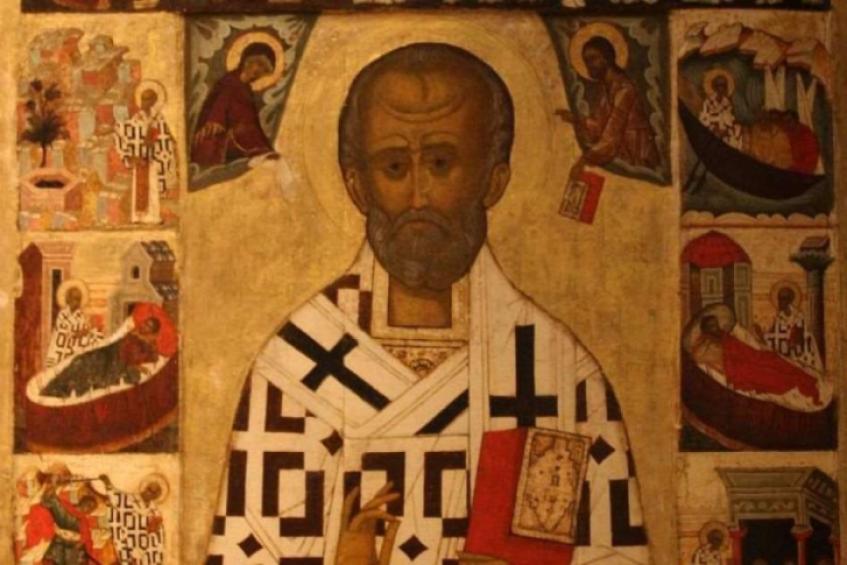-share.jpg)
,,If you want to start a spirited debate at your next holiday meal, ask your guests which country invented wine. France, Italy, or Greece might come to mind.
But most scholars say Georgia - the small former Soviet Republic, is the birthplace of wine. Scientists say wine residue found on pieces of pottery in Georgia dates back 8,000-years.
The country of nearly four million shares a border with Russia and has survived thousands of years of invasions and wars. Multiple dynasties have come and gone. But somehow, many Georgian grapes survived.
Tonight, we'll take you on a journey through Georgia to meet the promoters and protectors of Georgia's ancient vines.
When you first set foot in Georgia's capital Tbilisi... she's hard to miss.
Perched high up over the city, the towering Mother of Georgia wields a sword in her right hand to fend off her enemies and a bowl of wine in her left to welcome friends.
That welcome and the country's deep history of winemaking winds through Georgia. The vines of city dwellers cling to tiny balconies.
Small family vineyards stretch along the countryside and larger producers export millions of bottles globally," - this is an excerpt from the report that aired a few days ago on the CBS program "60 Minutes".
CBS, one of the most rated and popular television broadcasters in the USA, aired an extensive story about the Diocese of Alaverdi and the Georgian monastic qvevri wine of Badagoni.
The "60 Minutes" program camera crew hosted by Badagon winery, visited the Alaverdi monastery and the Badagoni factory, where the unique monastery kvevri wine is made.
A CBS journalist and author of the story, Sharyn Alfonsi, talks extensively about the "Little Georgia, which is the birthplace of wine and has 8,000 years of history."
Sharyn Alfonsi recorded an interview with Abba Alaverdeli Metropolitan David.
,,But to fully understand the rich history of wine in Georgia, we went to the fertile River Valley of Kakheti to see the Alaverdi Monastery.
At the foot of the Caucasus Mountains, the monastery looks like a fortress. We were invited inside its walls.
Our host was Georgian Orthodox Bishop David.
He oversees three monks who live on the grounds of the medieval compound. It is a quiet life, committed to god and the godly pursuit of creating a perfect glass of wine."
Sharyn Alfonsi: How many bottles of wine do you make here a year?
Bishop David (translated): 20,000 bottles with a maximum of 50,000 bottles. Our wine cellar's capacity is 30 tons of wine.
Sharyn Alfonsi: Four monks, 20,000 bottles. This is a lot of work. Do they ever sleep?
Bishop David (translated): We sleep, and work at the same time. (laughs)
Locals help work the land. But for centuries, the monks have been the guardians of these ancient vines.
The monastery dates back to the sixth century, Bishop David told us, vines were planted on day one.
Sharyn Alfonsi: Does making wine make you feel closer to God?
Bishop David (translated): Of course. Whenever we are in the vineyard or the wine cellar, we always feel that God is close to us. Grapes have long held a sacred place in Georgia. In ancient times, wine was considered a divine drink and offered to the gods to win favor.
Georgian soldiers tied a piece of grapevine inside the chest of their uniforms to protect them and to assure that if they died in battle, a vine would sprout from their heart.
Man was mortal, but Georgian vines – eternal.
For centuries the Georgian monks have made wine the same way. Producing reds, whites. and even, "ambers"….more on that in a moment.
The process is uniquely Georgian. Under the monastery, buried six feet deep in the ground, giant clay pots called qvervi are used to ferment, store and age the wine.
It is the traditional way to make wine in Georgia. Many homes have qveris in their cellar. But today there are only a handful of qveri makers who carry on the tradition of hand building these clay beasts. Some hold nearly 900 gallons of wine.
Pressed grapes, skins, stalks and the juice are all mixed into the qveri, which is buried in the ground to maintain a constant temperature.
Every day during the harvest, the monks make their way through the hallowed halls of the monastery to bless the wine cellar, the grapes, and toast the bounty their vineyards bring.
Most of the monk's wine is sold. Some is shared during Sunday communion inside the Alaverdi Cathedral.
On this day, a haunting chant stirred inside the cathedral dome.
The chant, called 'you are the vineyard,' was written 900 years ago by a former king turned monk to honor Georgia's deep connection to its religion and wine.
Lit by candles, it's hard to see the scars of the cathedral. It survived earthquakes and invasions.
In an attempt to erase Georgian culture, Russians whitewashed the cathedral interiors in the 20th century, covering up 11th century frescoes, and used the monastery's qveris to store their gasoline.
But miraculously, many of the vines were unharmed.
Bishop David says today, 100 grape varieties, some dating back 900 year, are still grown on the monastery's grounds.
Sharyn Alfonsi: And how does the wine taste?
Bishop David (translated): Not to talk about taste, it's better to taste it ourselves.
Sitting near the ancient qveris, the bishop opened a bottle.
Bishop David (translated): When tasting the qveri wine for the first time, a person might think they are trying something very different.
Sharyn Alfonsi: Oh it does look golden, amber. Look at that color!
Bishop David (translated): And they say in Georgia that-- "The eye drinks and the eye eats", that's what we have to be thankful to God.
Sharyn Alfonsi: There's much to be thankful to God in this glass.
Bishop David (translated): Of course, it could not be any other way.
,,Heavenly, with notes of citrus, spices and honey. It is complex, like the history of Georgia, but in a glass", - the journalist notes.
See the full version of the program at the link below:
0
0
One US dollar trades at GEL 2.6984
19/12/2025










